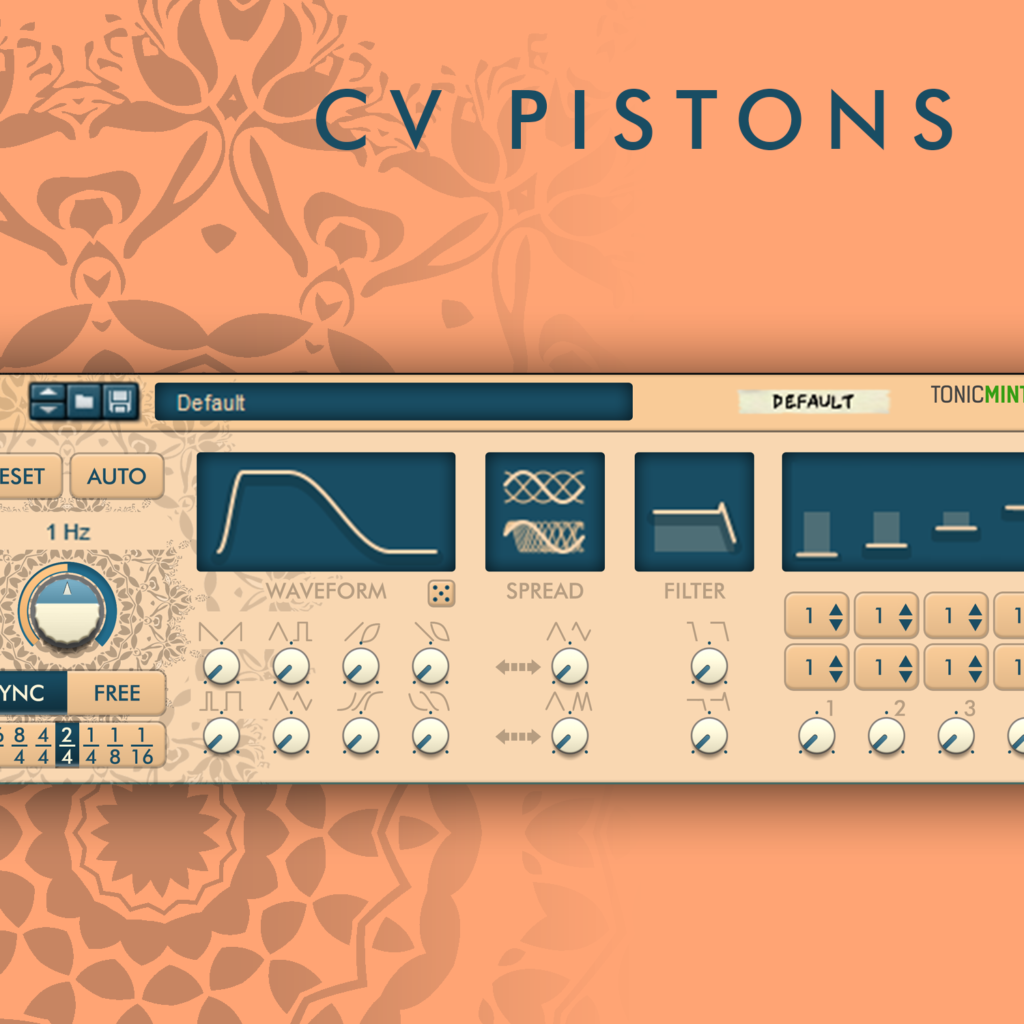
- 8 LFOs
- with shared waveforms
- which breathe together
regular price
Check this in the Reason Studio's Add-On Shop
Go to the shop
8 LFOs with shared waveforms which breathe together. This is CV Pistons
in a nutshell.
The first thing to mention is the adjustable waveform. Using only a few parameters we can easily create triangles, ramps and squares, but also curved waveforms such as sines or exponential or logarithmic curves and also anything between these.
CV Pistons has 8 LFOs, the frequency of each LFO being based on a common fundamental/base frequency. This fundamental/base frequency can be synced to our song, or alternatively set freely in a very wide range.
Each LFO has a multiplier and a divider (a rational multiplier with a numerator and a denominator) used to set the relative frequency of the LFO. This enables the creation of harmonic or subharmonic or even other polyrhythmic frequency series.
You may have noticed the negative numbers in the numerator. Negative frequency is usually nonsense, but here it means the oscillator is working/reading the waveform backward.
The manipulation possibilities do not end here. You also can also modify the phase and the frequency continuously using the spread controls. Using one knob you can shift the phases of the LFOs more and more (or less and less), or you can set the speed faster and faster (or slower and slower).
Each control on CV Pistons has immediate effect with no parameter interpolation applied resulting in smoother operation. This allows you to get really weird with this device. But what if the result is too strange? Well, this is why we added a low pass filter for the LFOs. With the filter you can control the smoothness of the result. This filter is the same as a low pass filter but with the addition of a resonance control.
Returning now to the LFOs. Each LFO has an attenuverter for scaling and inverting the signal as required.
Finally, each LFO has a bipolar and an unipolar output. We also have a pair of mixed outputs, where the mix is based on the attenuverters of the LFOs.
Waveform
Waveform can be adjusted by the skew, squarish, pulse width, phase, curve type, curve strength knobs. Curve settings work independently for upward and downward signals.
Base frequency
The base frequency can be synced. To the intervals: 16/4,8/4,4/4,2/4,1/4,1/8,1/16
No dotted intervals or triplets, quintuplets here, because by using the individual LFO settings even more complex results can be achieved.
The base frequency can be set freely in any interval. In this case you can set the "from" and the "to" value of the frequency range, with the frequency knob working exponentially within the intervals 1h, 10min, 1min, 30sec, 20sec, 10sec(0.1Hz), 5sec(0.2Hz), 2sec(0.5Hz), 1Hz, 2Hz, 5Hz, 10Hz, 20Hz, 30Hz, 50Hz repectively.
LFOs
Each LFO has a frequency multiplier and divider. The Multiplier (numerator) can be set between -16 and +16 (integer numbers, except 0).
The Divider (denominator) can be set between 1 and 32.
The Level can be set between -100% and 100%. Negative values mean inverted signals.
Spread controls
Phase spread: increases or decreases the phases of the LFOs continuously.
When the LFO multipliers are 1/1 and the Phase spread settings are 50% then the 5th LFO phase offset will be a half cycle.
When the settings are 100% then the 5th LFO phase offset will be a full cycle (the 5th LFO will be synced with the 1st LFO)
Frequency spread: increase or decreases the frequencies of the LFOs continuously.
When the LFO multipliers are 1/1 and the Freq spread settings are 100% then the 5th LFO will have twice the frequency.
When the Freq spread settings is -100% then the 5th LFO will have half the frequency.
CV Pistons displays the spreads as a sine wave series for better visual understanding. Of course, the waveforms come from the waveform settings.
Filter
Each LFO has its own low pass filter, but the settings of these filters are shared. When the cutoff is 100%, the output will not be filtered.
The frequency knob works on an exponential scale, and the resonance knob works on an extreme logarithmic scale. The Mix channel has no filter of its own.
Outputs
Each LFO has its own unipolar and bipolar CV outputs. The Mix outputs are calculated by the LFOs, where the level settings are the weights for the LFO values.
Other controls/inputs
Reset button: Restarts the LFOs
Auto button: When turned on the LFOs will be reset when the main sequencer of Reason is restarted.
Dice: Drops random numbers for the waveform values or the LFO settings
Trigger CV input: When the signal is changed from 0 (or less) to a value which is greater than 0 the LFOs will be reset.
Freq CV Mod input: When the base frequency setting is in Free mode, the base frequency can be manipulated using CV. This CV input value modifies the base frequency knob setting. When the base frequency is modified by CV a little up or down arrow is displayed in the frequency indicator.
